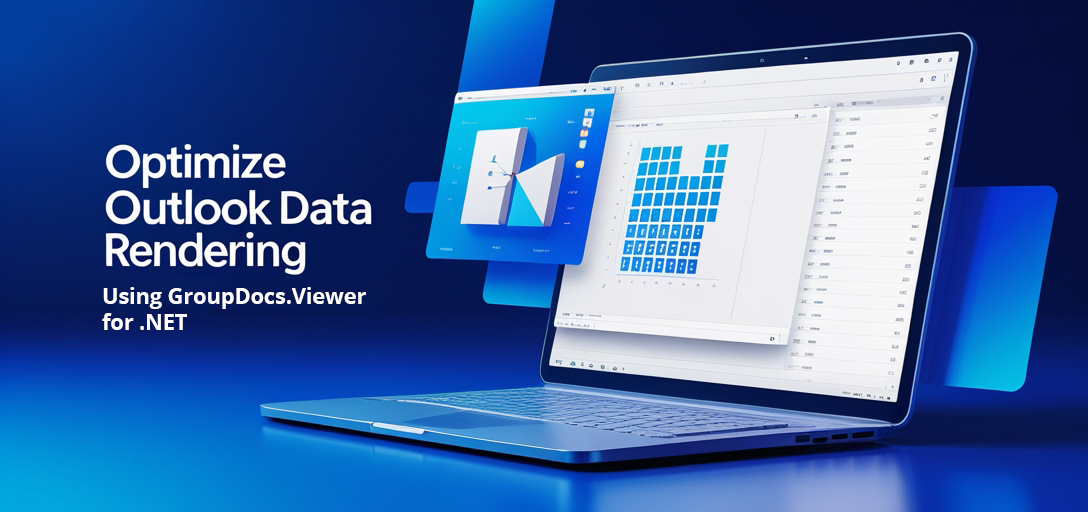Optimize Outlook Data Rendering with GroupDocs.Viewer .NET
Introduction
Are you facing challenges with rendering large amounts of data from your Outlook files like .ost or .pst? With millions of emails stored in these files, displaying all at once can lead to performance issues and overwhelm users. This tutorial will guide you through using GroupDocs.Viewer for .NET to efficiently limit the number of items rendered, optimizing both user experience and system resources.

What You’ll Learn:
- How to set up GroupDocs.Viewer for .NET
- Limiting data rendering in Outlook files with C#
- Best practices for performance optimization
Transition from understanding this challenge to implementing a solution is straightforward. Let’s dive into the prerequisites you need to get started.
Prerequisites
Before we begin, ensure you have the following:
Required Libraries and Versions:
- GroupDocs.Viewer for .NET - Version 25.3.0 or higher
- A development environment supporting C# (.NET Framework or .NET Core)
Environment Setup Requirements:
- Visual Studio (2017 or later) with .NET support
Knowledge Prerequisites:
- Basic understanding of C#
- Familiarity with handling file paths and directories in .NET
Setting Up GroupDocs.Viewer for .NET
To start using GroupDocs.Viewer, you need to install the library. You can do this via NuGet or the .NET CLI.
NuGet Package Manager Console:
Install-Package GroupDocs.Viewer -Version 25.3.0
.NET CLI:
dotnet add package GroupDocs.Viewer --version 25.3.0
License Acquisition Steps:
- Free Trial: Begin with a free trial by downloading the library from GroupDocs’ release page.
- Temporary License: Apply for a temporary license on their purchase site to test without limitations.
- Purchase: For full access, purchase a license via the GroupDocs purchase portal.
Basic Initialization and Setup with C#
Here’s how you can initialize GroupDocs.Viewer in your .NET application:
using System;
using GroupDocs.Viewer;
// Create an instance of Viewer to work with a sample Outlook data file.
using (Viewer viewer = new Viewer("path_to_your_outlook_file.ost"))
{
// Configuration and rendering logic will go here.
}
Implementation Guide
Limiting Items in Outlook Data Rendering
This feature allows you to control the number of items displayed per folder, enhancing performance by reducing load times.
Overview
By setting a maximum item count, only specified numbers of emails are rendered at once. This can be particularly useful for large .ost or .pst files with thousands of entries.
Implementation Steps
Step 1: Set Up the Viewer Instance
First, initialize the Viewer object pointing to your Outlook data file:
using (Viewer viewer = new Viewer("path_to_your_outlook_file.ost"))
{
// Additional setup and rendering options will be specified here.
}
Step 2: Configure HTML View Options
Next, configure how you want the items displayed. Here we use HtmlViewOptions to render as embedded resources:
string outputDirectory = @"YOUR_OUTPUT_DIRECTORY/";
string pageFilePathFormat = Path.Combine(outputDirectory, "page_{0}.html");
HtmlViewOptions options = HtmlViewOptions.ForEmbeddedResources(pageFilePathFormat);
Step 3: Limit the Number of Items Rendered
Set MaxItemsInFolder to control how many items are displayed per folder:
options.OutlookOptions.MaxItemsInFolder = 3;
This configuration ensures only three emails from each folder are rendered at a time.
Step 4: Render the Document
Finally, use the View method to render your document with these options:
viewer.View(options);
Troubleshooting Tips:
- File Path Errors: Ensure paths in
Viewerinitialization andpageFilePathFormatare correct. - Rendering Issues: Verify that the
.ostfile is not corrupted or inaccessible.
Practical Applications
GroupDocs.Viewer can be integrated into various applications, including:
- Email Management Systems: Optimize email viewing experiences by rendering only necessary items.
- Archival Solutions: Efficiently preview large archives without loading all data at once.
- Legal Document Review Platforms: Facilitate document review processes with selective item displays.
Performance Considerations
Optimizing Performance
- Use
MaxItemsInFolderto manage resource usage effectively. - Choose appropriate output formats like HTML for lightweight rendering.
Resource Usage Guidelines
- Regularly clean up rendered outputs from temporary directories.
- Monitor system memory during rendering to prevent overuse.
Best Practices for Memory Management:
- Dispose of Viewer instances properly using the
usingstatement. - Avoid loading entire files into memory when possible; render them in parts instead.
Conclusion
By implementing GroupDocs.Viewer for .NET, you can significantly enhance your application’s performance and user experience when dealing with Outlook data files. Limiting item counts per folder ensures that your system remains responsive even under heavy loads.
Next steps include exploring other features of GroupDocs.Viewer or integrating it into larger systems for comprehensive document management solutions. Try implementing the solution today to see its benefits firsthand!
FAQ Section
Q1: How do I handle large .ost files with GroupDocs.Viewer?
A: Use MaxItemsInFolder to render manageable chunks of data.
Q2: Can GroupDocs.Viewer be used in a web application? A: Yes, it can be integrated into ASP.NET applications for server-side rendering.
Q3: What file formats are supported by GroupDocs.Viewer for .NET?
A: It supports various document formats including Outlook data files like .ost and .pst.
Q4: How do I obtain a license for GroupDocs.Viewer? A: Licenses can be acquired through their purchase portal.
Q5: Is there support for .NET Core applications? A: Yes, GroupDocs.Viewer is compatible with both .NET Framework and .NET Core.
Resources
- Documentation: GroupDocs Viewer Documentation
- API Reference: GroupDocs API Reference
- Download: GroupDocs Downloads
- Purchase: Buy GroupDocs License
- Free Trial: Start Your Free Trial
- Temporary License: Apply for a Temporary License
- Support: GroupDocs Support Forum
Try implementing GroupDocs.Viewer in your projects today and experience streamlined document rendering like never before!